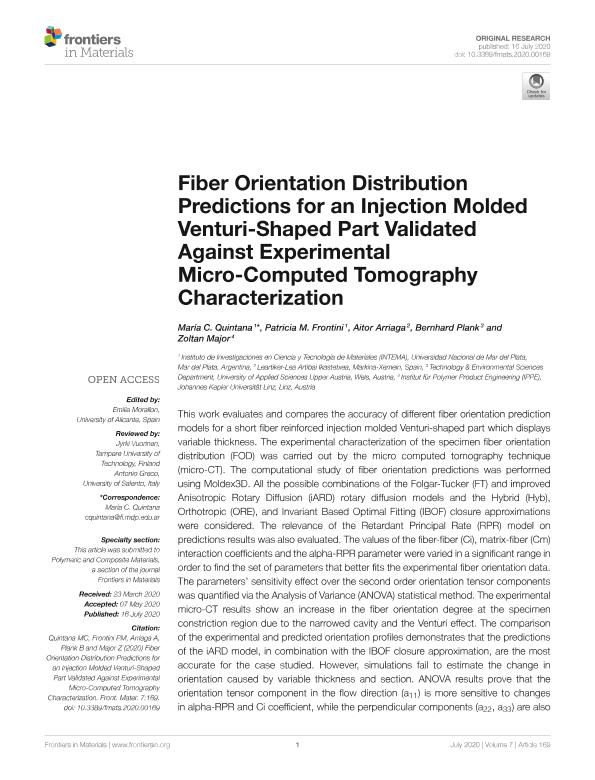Mostrar el registro sencillo del ítem
dc.contributor.author
Quintana, María Camila

dc.contributor.author
Frontini, Patricia Maria

dc.contributor.author
Arriaga, Aitor
dc.contributor.author
Plank, Bernhard
dc.contributor.author
Major, Zoltan
dc.date.available
2021-08-30T12:23:33Z
dc.date.issued
2020-07
dc.identifier.citation
Quintana, María Camila; Frontini, Patricia Maria; Arriaga, Aitor; Plank, Bernhard; Major, Zoltan; Fiber Orientation Distribution Predictions for an Injection Molded Venturi-Shaped Part Validated Against Experimental Micro-Computed Tomography Characterization; Frontiers Media S.A.; Frontiers in Materials; 7; 7-2020; 169
dc.identifier.issn
2296-8016
dc.identifier.uri
http://hdl.handle.net/11336/139174
dc.description.abstract
This work evaluates and compares the accuracy of different fiber orientation prediction models for a short fiber reinforced injection molded Venturi-shaped part which displays variable thickness. The experimental characterization of the specimen fiber orientation distribution (FOD) was carried out by the micro computed tomography technique (micro-CT). The computational study of fiber orientation predictions was performed using Moldex3D. All the possible combinations of the Folgar-Tucker (FT) and improved Anisotropic Rotary Diffusion (iARD) rotary diffusion models and the Hybrid (Hyb), Orthotropic (ORE), and Invariant Based Optimal Fitting (IBOF) closure approximations were considered. The relevance of the Retardant Principal Rate (RPR) model on predictions results was also evaluated. The values of the fiber-fiber (Ci), matrix-fiber (Cm) interaction coefficients and the alpha-RPR parameter were varied in a significant range in order to find the set of parameters that better fits the experimental fiber orientation data. The parameters' sensitivity effect over the second order orientation tensor components was quantified via the Analysis of Variance (ANOVA) statistical method. The experimental micro-CT results show an increase in the fiber orientation degree at the specimen constriction region due to the narrowed cavity and the Venturi effect. The comparison of the experimental and predicted orientation profiles demonstrates that the predictions of the iARD model, in combination with the IBOF closure approximation, are the most accurate for the case studied. However, simulations fail to estimate the change in orientation caused by variable thickness and section. ANOVA results prove that the orientation tensor component in the flow direction (a11) is more sensitive to changes in alpha-RPR and Ci coefficient, while the perpendicular components (a22, a33) are also significantly affected by Cm. From the predictive error analysis it is seen that the optimal parameters set to capture the orientation state of the specimen is: (i) for the FT model, Ci = 0.005, alpha-RPR = 0.7 and (ii) for the iARD model, Ci = 0.005, Cm = 0.2, and alpha-RPR = 0.7.
dc.format
application/pdf
dc.language.iso
eng
dc.publisher
Frontiers Media S.A.

dc.rights
info:eu-repo/semantics/openAccess
dc.rights.uri
https://creativecommons.org/licenses/by/2.5/ar/
dc.subject
CLOSURE APPROXIMATIONS
dc.subject
EXPERIMENTAL VALIDATION
dc.subject
INJECTION MOLDING SIMULATION
dc.subject
MICRO-CT CHARACTERIZATION
dc.subject
ROTARY DIFFUSION MODELS
dc.subject
SHORT-FIBER COMPOSITES
dc.subject.classification
Compuestos

dc.subject.classification
Ingeniería de los Materiales

dc.subject.classification
INGENIERÍAS Y TECNOLOGÍAS

dc.title
Fiber Orientation Distribution Predictions for an Injection Molded Venturi-Shaped Part Validated Against Experimental Micro-Computed Tomography Characterization
dc.type
info:eu-repo/semantics/article
dc.type
info:ar-repo/semantics/artículo
dc.type
info:eu-repo/semantics/publishedVersion
dc.date.updated
2021-08-19T20:32:44Z
dc.journal.volume
7
dc.journal.pagination
169
dc.journal.pais
Países Bajos

dc.journal.ciudad
Amsterdam
dc.description.fil
Fil: Quintana, María Camila. Consejo Nacional de Investigaciones Científicas y Técnicas. Centro Científico Tecnológico Conicet - Mar del Plata. Instituto de Investigaciones en Ciencia y Tecnología de Materiales. Universidad Nacional de Mar del Plata. Facultad de Ingeniería. Instituto de Investigaciones en Ciencia y Tecnología de Materiales; Argentina
dc.description.fil
Fil: Frontini, Patricia Maria. Consejo Nacional de Investigaciones Científicas y Técnicas. Centro Científico Tecnológico Conicet - Mar del Plata. Instituto de Investigaciones en Ciencia y Tecnología de Materiales. Universidad Nacional de Mar del Plata. Facultad de Ingeniería. Instituto de Investigaciones en Ciencia y Tecnología de Materiales; Argentina
dc.description.fil
Fil: Arriaga, Aitor. Johannes Kepler University Linz; Austria
dc.description.fil
Fil: Plank, Bernhard. University of Applied Sciences Upper; Austria
dc.description.fil
Fil: Major, Zoltan. Johannes Kepler University Linz; Austria
dc.journal.title
Frontiers in Materials
dc.relation.alternativeid
info:eu-repo/semantics/altIdentifier/doi/http://dx.doi.org/10.3389/fmats.2020.00169
dc.relation.alternativeid
info:eu-repo/semantics/altIdentifier/url/https://www.frontiersin.org/articles/10.3389/fmats.2020.00169/full
Archivos asociados
